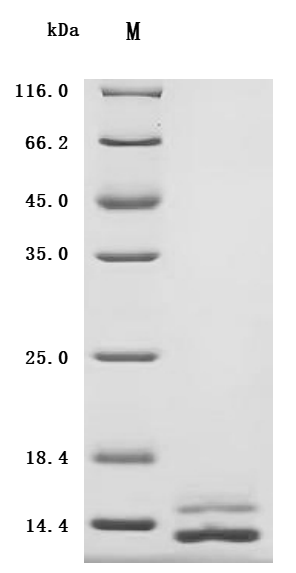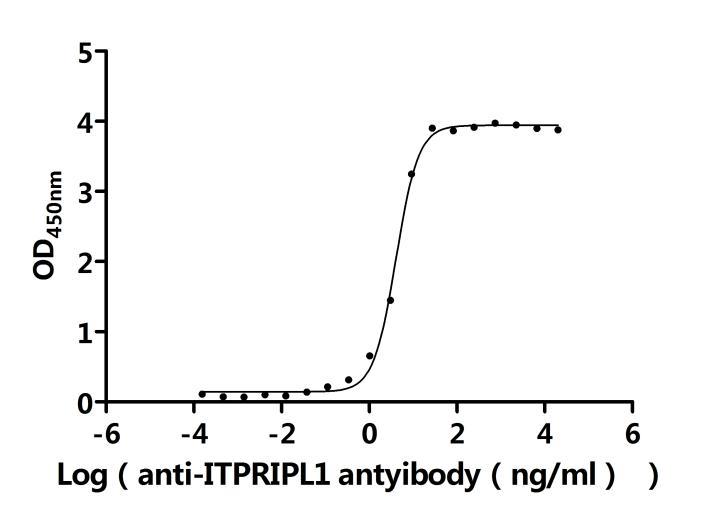The recombinant Macaca fascicularis ITPRIPL1 protein is an active, high-purity product synthesized in mammalian cells to ensure proper protein folding and native post-translational modifications. It includes amino acids 25 to 103 of the macaque ITPRIPL1 protein and carries a C-terminal 10xHis tag for efficient purification and detection. Supplied as a lyophilized powder, the recombinant ITPRIPL1 protein exhibits greater than 95% purity, confirmed by SDS-PAGE, and has low endotoxin levels, maintained below 1.0 EU/µg as determined by the LAL assay. Functional activity is verified in a binding ELISA, where immobilized ITPRIPL1 at 2 μg/mL shows specific interaction with the anti-ITPRIPL1 recombinant antibody (CSB-RA756966MA1HU), yielding an EC50 value between 3.759 and 4.428 ng/mL. These properties make the ITPRIPL1 protein a reliable tool for antibody screening, protein interaction studies, and functional research involving ITPRIPL1.
The ITPRIPL1 protein from Macaca fascicularis, also known as the cynomolgus macaque or long-tailed macaque, is part of the inositol 1,4,5-trisphosphate receptor (ITPR) family, which plays significant roles in calcium signaling pathways essential for various cellular processes. Although not extensively characterized in M. fascicularis, general research indicates that ITPR proteins are involved in intracellular calcium release, which is pertinent for muscle contraction, neurotransmitter release, and cell proliferation. Such functionality has been illustrated in several studies across different species, linking disruptions in calcium signaling to a range of physiological and pathological processes.
Research has shown that Macaca fascicularis has unique adaptations in their protein structures that could influence these signaling pathways. For example, studies into the evolutionary trajectories of Macaca species suggest potential variations in their receptor functionalities due to historical events such as hybridization and gene flow [1][2]. Such adaptations may affect the expression levels and activities of proteins like ITPRIPL1, potentially leading to different regulatory mechanisms compared to closely related primate species [2][3].
Additionally, the relevance of genetic studies on Macaca fascicularis is highlighted in the context of biomedical research. These animals are frequently used as non-human primate models to study human diseases, with an emphasis on understanding gene function and regulation [4][5]. Therefore, there are direct implications on how the expression and functionality of ITPRIPL1 may be utilized in modeling human pathologies, particularly those related to calcium signaling dysregulation, such as neurodegenerative diseases or cardiac dysfunctions [6].
The unique genomic characteristics of the M. fascicularis population contribute to their importance in biomedical research contexts. It is posited that proteins like ITPRIPL1 in cynomolgus macaques can assist in deciphering complex biological responses and may offer insights into therapeutic interventions for various diseases in humans, making research on such proteins critical [7][6].
References:
[1] D. Vanderpool, B. Minh, R. Lanfear, D. Hughes, S. Murali, R. Harriset al.Primate phylogenomics uncovers multiple rapid radiations and ancient interspecific introgression. Plos Biology, vol. 18, no. 12, p. e3000954, 2020. https://doi.org/10.1371/journal.pbio.3000954
[2] N. Osada, K. Matsudaira, Y. Hamada, & S. Malaivijitnond.Testing sex-biased admixture origin of macaque species using autosomal and x-chromosomal genomic sequences. Genome Biology and Evolution, 2020. https://doi.org/10.1093/gbe/evaa209
[3] Y. Hamada, A. San, & S. Malaivijitnond.Assessment of the hybridization between rhesus (macaca mulatta) and long‐tailed macaques (m. fascicularis) based on morphological characters. American Journal of Physical Anthropology, vol. 159, no. 2, p. 189-198, 2015. https://doi.org/10.1002/ajpa.22862
[4] J. Uli, C. Yong, et al. Rna sequencing (rna-seq) of lymph node, spleen, and thymus transcriptome from wild peninsular malaysian cynomolgus macaque (macaca fascicularis). Peerj, vol. 5, p. e3566, 2017. https://doi.org/10.7717/peerj.3566
[5] S. Laila, D. Astuti, I. Suparto, E. Handharyani, T. Register, & D. Sajuthi. Atherosclerotic lesion of the carotid artery in indonesian cynomolgus monkeys receiving a locally sourced atherogenic diet. Veterinary Sciences, vol. 9, no. 3, p. 105, 2022. https://doi.org/10.3390/vetsci9030105
[6] H. Darusman, S. Mariya, et al. Spontaneous expression of the gene of ki67 and p53 in cynomolgus monkeys infected with papillomavirus. Veterinary World, p. 962-967, 2022. https://doi.org/10.14202/vetworld.2022.962-967
[7] M. Abdul‐Latiff, F. Ruslin, H. Faiq, M. Salleh, J. Rovie‐Ryan, P. Abdul‐Patahet al.Continental monophyly and molecular divergence of peninsular malaysia’smacaca fascicularis fascicularis. Biomed Research International, vol. 2014, p. 1-18, 2014. https://doi.org/10.1155/2014/897682








